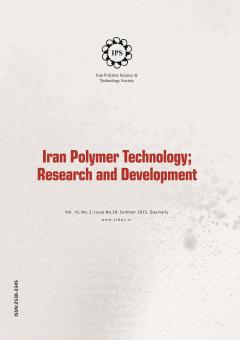A Review of the Production Process and Characterization of Polymer Components in Multilayer Medical Packaging
Subject Areas : پلیمرها در انرژی و کاربردهای بهداشتی و محیطیMohammad Mahdi Ashtari Barzoki 1 * , Ehsan Gaini 2 *
1 -
2 - Department of Polymer Engineering, Faculty of Chemical Engineering, Tehran
Keywords: Multilayer films, polymer packaging, co-extrusion, barrier properties, medical applications, additive optimization. ,
Abstract :
Multilayer polymer films are widely used in medical and food packaging due to their excellent barrier properties, mechanical strength, thermal properties and flexibility. These films consist of multiple polymer layers, each designed to provide specific characteristics such as oxygen/moisture resistance, radiation protection, durability and microbial protection. In medical applications, they ensure the safety and integrity of blood and pharmaceutical products during storage and transportation. Common manufacturing processes include co-extrusion and lamination, which combine barrier layers (e.g., EVOH, PVDC), bulk layers (e.g., PE, PP), and sealing layers (e.g., LDPE, EVA) to optimize performance. Additives such as antioxidants, UV stabilizers, and slip agents enhance thermal stability and surface functionality. Advanced characterization techniques like SEM microscopy, FTIR spectroscopy, and DSC thermal analysis evaluate layer composition and behavior. Key parameters like gas/water vapor permeability are controlled using materials like EVOH (superior oxygen barrier) and polyethylene (excellent moisture resistance). Interlayer adhesion challenges are addressed through adhesive or compatibilizer layers. Innovations in extrusion and lamination technologies enable precise layer thickness control, improving efficiency, cost-effectiveness, and product shelf life. This review highlights the critical importance of material selection, additive formulation, and process optimization in developing high-performance multilayer films for healthcare and food preservation applications.
G. L. Robertson, Food Packaging. CRC Press, 2016. K. Marsh and B. Bugusu, “Food packaging—roles, materials, and environmental issues,” J. Food Sci., vol. 72, no. 3, pp.
R39–R55, 2007. S. Jadhav, S. Gyan, and V. Univeristy, “Study of different methods of Pharmaceutical Packaging. Sapana,” vol. XV, no.
February, pp. 254–277, 2023. T. Rydzkowski, J. Wróblewska-Krepsztul, V. K. Thakur, and T. Królikowski, “Current trends of intelligent, smart packagings
in new medical applications,” Procedia Comput. Sci., vol. 207, pp. 1271–1282, 2022, doi: 10.1016/j.procs.2022.09.183. A. Hasanvand, “A Review of Multilayer Flexible Packaging Structures,” J. Packag. Sci. Technol., vol. 14, no. 2, pp. 45–56,
2023.
Y. Teck Kim, B. Min, and K. Won Kim, General Characteristics of Packaging Materials for Food System. Elsevier Ltd, 2013. S. Roy, T. Ghosh, W. Zhang, and J. W. Rhim, “Recent progress in PBAT-based films and food packaging applications: A
mini-review,” Food Chem., vol. 437, no. P1, p. 137822, 2024, doi: 10.1016/j.foodchem.2023.137822. G. Bang and S. W. Kim, “Biodegradable poly(lactic acid)-based hybrid coating materials for food packaging films with gas
barrier properties,” J. Ind. Eng. Chem., vol. 18, no. 3, pp. 1063–1068, 2012, doi: 10.1016/j.jiec.2011.12.004. M. Ščetar, M. Kurek, and K. Galić, “Trends in Fruit and Vegetable Packaging,” Univ. Zagreb. Fac. food Technol. Biotechnol.
Pierottijeva 6, 10000 Zagreb. Croat., vol. 5, no. 3–4, pp. 69–86, 2010.
M. Ščetar, Multilayer packaging materials. 2021.
K. L. Yam, The Wiley encyclopedia of packaging technology. John Wiley & Sons, 2010. A. ;ب Mieth, C. ; Simoneau, and E. Hoekstra, Guidance for the identification of polymers in multilayer-LBNA27816ENN.
2016.
W. J. John R, Multilayer Flexible Packaging. 2010.

